A milestone for Expo—and the Westside
February 4, 2010
The Expo Line is ready to roll west.
Directors of the Exposition Metro Line Construction Authority on Thursday evening approved the final environmental impact report for Phase 2 of the light rail project after years of study and months of community input and debate.
The vote clears the way for selection of a contractor to design and build the $1.5 billion project, which would complete the Culver City- to-Santa Monica segment of the 15.2-mile line.
Construction on Phase 1, which parallels the heavily-congested Santa Monica Freeway and runs from downtown to Culver City, is now underway and aiming for completion in 2011. Some work on Phase 2 could begin as early as this year, with the project scheduled to wrap up in 2015. By 2030, the entire line is projected to carry 64,000 riders a day.
Proponents of the line say it will be a boon for anyone who drives to, or from, the Westside, especially those who must battle traffic on the 10 Freeway. For tourists, students and the region as a whole, the completed light rail line will provide access to an array of cultural and community venues in downtown and beyond, including Exposition Park/USC, the Crenshaw District and the beach.
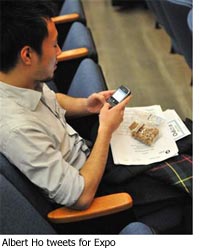 The vote attracted considerable attention, with hundreds of people on all sides of the issue attending the meeting in the Hall of Administration. In addition, Expo was a hot topic for social networking, with one blogger—Damien Newton of Streetsblog Los Angeles—delivering play-by-play reports on the meeting via Twitter. Albert Ho, an Expo community outreach consultant, also tweeted throughout the proceedings.
The vote attracted considerable attention, with hundreds of people on all sides of the issue attending the meeting in the Hall of Administration. In addition, Expo was a hot topic for social networking, with one blogger—Damien Newton of Streetsblog Los Angeles—delivering play-by-play reports on the meeting via Twitter. Albert Ho, an Expo community outreach consultant, also tweeted throughout the proceedings.
Opponents, many of them with a group called Neighbors for Smart Rail, said they were not against a rail system per se but wanted it to run underground for reasons of safety and quality of life. That option has been ruled out, in part because of the cost.
Those speaking in favor of the plan—an array of homeowners, business people, educators, college students and political leaders from across the region—offered testimony that focused on the need to solve the area’s traffic overload, bring workers to Westside jobs and deliver on the will of the voters who approved Measure R, which will largely finance the rail line.
After nearly four hours of public testimony, the Expo board members had their say.
“This part of town, this part of the county, has waited a long time for this. The time for action has come,” said Zev Yaroslavsky, Expo board member and 3rd District County Supervisor. (Read his blog on the Expo Line project here.)
The Expo Line—together with another project now in the planning stages, the Westside Subway extension—will represent a transit breakthrough for a jobs-rich area that has had to rely on buses for its mass transportation needs as a region-wide rail system has grown up around it in recent decades.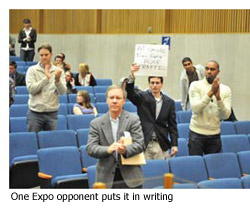
When all is completed, the Expo Line will make it possible to travel from downtown Los Angeles to Culver City in less than 30 minutes, and to ride the entire length of the line in 46 minutes.
“It’s a big step forward for the region,” said Expo board member and Culver City Councilmember Scott Malsin.
“With 200,000 cars coming [into Santa Monica] every day, every one of my streets is gridlocked. I’ve had it up to here with gridlock,” added board member Bill Rosendahl, acting as alternate for his L.A. City Council colleague Jan Perry.
Yaroslavsky, Malsin and Rosendahl joined L.A. City Councilmembers Herb Wesson, Jr. and Bernard C. Parks and Santa Monica City Councilmember Gleam Davis in approving the final environmental impact report. Dan Rosenfeld, acting as alternate for County Supervisor Mark Ridley-Thomas, abstained.
Ridley-Thomas, before leaving the meeting early, had offered a motion that would have delayed a decision on the report until the Metro CEO could finish a review of the agency’s grade crossing policy. That motion was defeated.
The route approved by Expo directors includes seven stations: National/Palms, Expo/Westwood, Expo/Sepulveda, Expo/Bundy, Olympic/26th Street, Colorado/17th Street and Colorado/4th Street.
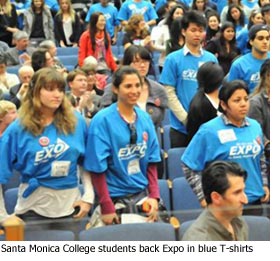 In preparing the final environmental review, the Expo staff received thousands of public comments on the project. Most were supportive but some raised key questions about traffic, grade crossings, parking, noise and vibration, the proximity to schools and the location of the project’s maintenance facility.
In preparing the final environmental review, the Expo staff received thousands of public comments on the project. Most were supportive but some raised key questions about traffic, grade crossings, parking, noise and vibration, the proximity to schools and the location of the project’s maintenance facility.
In addressing those concerns, Expo staff made a number of modifications in the environmental plan presented to the board of directors.
The “locally preferred alternative” plan recommended new elevated grade separations at a number of intersections: Venice Boulevard, Bundy, Centinela, Pico-Gateway, Cloverfield/Olympic and Sawtelle.
More changes came from the Expo board Thursday. On a motion by Yaroslavsky, the directors included an option to build an aerial station at Expo/Sepulveda if funding could be found. The plan also calls for a 170-space parking lot at the Westwood Boulevard station. But the board approved a motion by Yaroslavsky to keep open the possibility of building the station without a parking lot. That could allow for the creation of a landscaped greenway at that location.
In addition, the plan presented to Expo directors recommended a “buffer design option” for the maintenance facility to be built in Santa Monica. The facility would be constructed on what is now a Verizon maintenance yard and a Santa Monica City College parking lot at Exposition Boulevard and Stewart Street. It would include a 100- to 110-foot buffer between the facility and a residential area on the south side of Exposition.
Other changes include allowing parking on the east side of Westwood Boulevard between 7 a.m. and 7 p.m. and doing more to mitigate noise and vibration around such locations as sound and recording studios and schools.
Expo officials describe the line as a “Transit Parkway” that will include pedestrian paths, trees and landscaping, and a bikeway along the alignment, all the way from downtown L.A to Santa Monica. The cities of Santa Monica and Los Angeles have finalized the bikeway design and are awaiting federal environmental approval of the plan.
The plan calls for awarding a preliminary engineering contract by March and a design and construction contract in the fall.




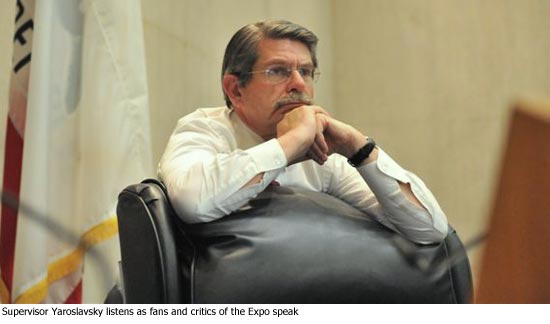
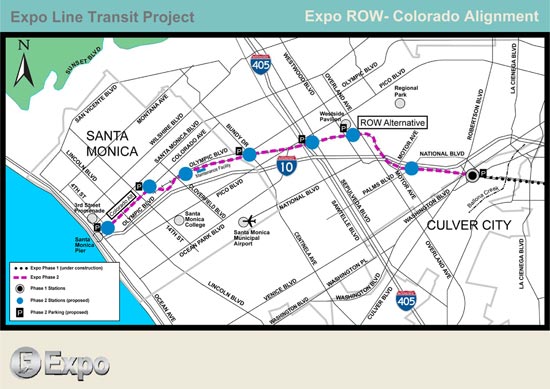








 405 bridge work causes a stink
405 bridge work causes a stink

